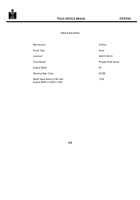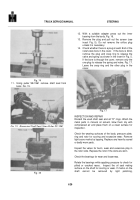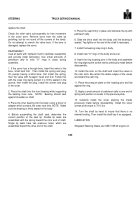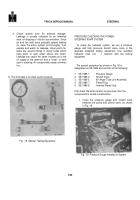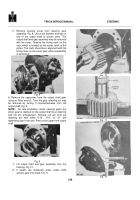TM-5-3805-254-14-P-2 - Page 638 of 894
TRUCK SERVICE MANUAL
STEERING
1. Fill reservoir to indicated level and replace cap.
2. Start engine and idle, turning wheels to the full
left and right three times. Shut off engine and
refill reservoir to indicated level.
3. Continue operation in step "2" until system
maintains its proper indicated oil level.
4. Run engine at faster speed and continue turning
wheels slowly from full left to full right and back
again for approximately five minutes to check for
leaks. This will bleed the system of air. Again
refill the reservoir to the indicated level or to 1-
1/2" below top of filler neck on reservoir without
dipstick attached to filler cap.
NOTE:
THE
ABOVE
INSTRUCTIONS
ARE
IMPORTANT.
TROUBLESHOOTING PROCEDURE
A. A
thorough
and
orderly
troubleshooting
procedure will help you diagnose power steering
troubles quickly. Troubles occur in many places,
show
uF
in various ways; but with this procedure,
you can eliminate many possibilities immediately,
narrow down the cause of trouble, then make
correct repairs promptly.
1. We
have
arranged
the
troubleshooting
procedure into three-steps:
a. Define the complaint.
b. External inspection.
c. Hydraulic system check.
2. This procedure is an overall one. By following it
step by step, you should be able to identify nearly
every trouble which may occur in a hydraulic
power steering system. As you become more
familiar with troubleshooting, you can leave out
some steps on some jobs.
B.
The first step in finding trouble is to define the
complaint. Properly identifying the complaint will
let you eliminate many possible causes at once.
Just like a doctor, you must know what and
where the trouble is before you can correct it.
1. When a driver brings in his truck with a
complaint, ask him to explain the trouble in his
own words. (Sometimes a driver expects easier
steering than his system is designed to give. ) As
you talk with him, make notes of his comments,
look the system over for obvious defects.
You
may spot at first glance such things as uneven
tire wear, evidence of leakage or a frame out of
line. Determine the type and arrangement of the
power steering system.
Here are some sample questions you should ask
the driver:
a. How does the steering act?
b. Does it act this way all the time?
c. Does it occur in only one direction?
d. Under what conditions does it usually occur?
e. Is it accompanied by unusual noises?
2. If after talking with the driver you are still unable
to define the complaint, ask him to accompany
you and drive the vehicle yourself. Observe
steering action, think, visualize the system in
operation.
Perform actions in which the driver
said trouble occurred; try other steering actions
too, to give you a complete and accurate
definition of the trouble. You may want to try
these steering actions:
a. Turn steering wheel while standing or moving
slowly.
(Standing
with
vehicle
loaded,
hydraulic power may not be sufficient. )
b. Steer in both directions while moving.
c. Turn steering wheel rapidly one or two turns in
both directions.
d. Observe action when traveling straight ahead.
C.
The second step is an external inspection.
Look
for the obvious defects first to save time.
1. Check hydraulic fluid reservoir for correct level.
Insufficient oil will cause loss of pressure and
hard steering. An extremely low supply may allow
air to enter the system causing a "growling" noise
and a "lump" in steering, A reservoir overflow
means it is too full, the filter is out of place or in
bad condition.
2. Check tire pressure and tire wear due to
improper alignment or balance. Faulty tires can
cause hard steering and other undesired steering
actions.
631
Back to Top



